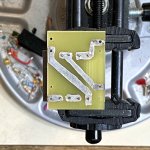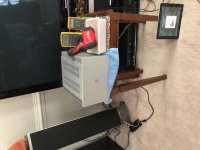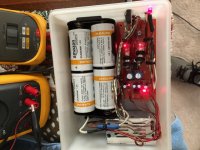TungstenAudio writes:
Are you sure you mean Edcor? Jensen Transformers recommends a specific secondary termination network including component values, but I haven't been able to find ANY recommended values on Edcor's website. Either for their PC series of matching transformers as a whole, or for the specific PC600-15K transformer used in the VFET front end.
(Parenthetically, since NP used a different RC network on the secondary of the same Edcor transformer in his M2 amplifier, it would mean at least one of them is contrary to Edcor's recommendation. M2 wrong / VFET wrong / maybe both. And the previous revisions of the VFET front end, which did not use the present 220pF+10K values, would also be contrary to Edcor's recommendation).
Zen Mod offered this observation:
_
... the original NP front end use the same secondary termination network that Edcor recommends for their transformer
Are you sure you mean Edcor? Jensen Transformers recommends a specific secondary termination network including component values, but I haven't been able to find ANY recommended values on Edcor's website. Either for their PC series of matching transformers as a whole, or for the specific PC600-15K transformer used in the VFET front end.
(Parenthetically, since NP used a different RC network on the secondary of the same Edcor transformer in his M2 amplifier, it would mean at least one of them is contrary to Edcor's recommendation. M2 wrong / VFET wrong / maybe both. And the previous revisions of the VFET front end, which did not use the present 220pF+10K values, would also be contrary to Edcor's recommendation).
LINK: Official M2 schematic
Zen Mod offered this observation:
which aligns nicely with the designer's decision to use different terminator RC values when different loads are driven, in VFET versus M2.shunting RC [is a] function of xformer loading
_
Last edited:
It looks like I may have to stand corrected on this.
I somehow had it stuck in my mind that this was from an Edcor datasheet. Must have been from one of the many Jensen datasheets that I've looked at instead.
I somehow had it stuck in my mind that this was from an Edcor datasheet. Must have been from one of the many Jensen datasheets that I've looked at instead.
The M2 Edcor is wired as a autoformer ( primary and secondary in series ) . The Sony VFET Edcor is wired as a transformer ( primary and secondary are seperate ) , I would think the Edcor would behave quite differently. Would the quasimodo test rig have any value in selecting the network on the Edcor ( just thinking outloud ) ?
I just looked at the resonant peak on the Edcor and swapped in a few RC
values until it had been tamed a bit (and not actually eliminated).

values until it had been tamed a bit (and not actually eliminated).

Quasimodo is a pulse generator that has sockets for quickly swapping components in a C+RC snubber of a power transformer. But its pulse repetition rate ("frequency") is not adjustable, the pulse amplitude is not easily adjustable, and although its falling edge waveshape is truly excellent, the rising edge is awful. So I definitely would not recommend Quasimodo for tuning a signal transformer's Zobel matching network.
It has been pointed to me in a PM that my original question (or rather the possible answers to my question) seem to lack objective / direction.I just looked at the resonant peak on the Edcor and swapped in a few RC
values until it had been tamed a bit (and not actually eliminated).

This that you mention Papa here was, more or less, what I was after. Knowing what that ringing “means” in term of sound and if it is a “desired” trait. It could very well be similar to how “higher” THD, when in the form of more presence of 2ndH, is something you actually include intentionally on your designs.
Or is it something we have to live with, but should we live in “perfect world” it would be something you would like to avoid.
Those were more or less my questions / doubts regarding the ringing. As I read it in your paper, it sounded like that wasn’t “ideal” while the output stage produced a “cleaner” result. So I sensed a tone of “I would have wanted this to be a tad better”. I may have read wrong, obviously, hence my timid (and apparently miss presented) question.
Thanks as always Papa for all your knowledge, your sharing and being the music in our lives!
Big hug,
Rafa.
Bulwark mezzanine
This is very much still work in progress..
My plan is to connect two primary coils of the Jensen 123-FLPCH in parallel and two secondary coils in series to get a 1:2 amplification factor. The remaining gain will come from the Bulwark circuit with appropriate values for the feedback resistors. I will be looking for an overall gain of about 17 dB.
This is obviously some pretty old school hand drawn artwork. The traces are much wider than necessary to allow for the imprecise nature of etching the copper in a Ferric Chloride solution. The boards were soaked in a Liquid Tin treatment to prevent oxidation.
This is very much still work in progress..
My plan is to connect two primary coils of the Jensen 123-FLPCH in parallel and two secondary coils in series to get a 1:2 amplification factor. The remaining gain will come from the Bulwark circuit with appropriate values for the feedback resistors. I will be looking for an overall gain of about 17 dB.
This is obviously some pretty old school hand drawn artwork. The traces are much wider than necessary to allow for the imprecise nature of etching the copper in a Ferric Chloride solution. The boards were soaked in a Liquid Tin treatment to prevent oxidation.
Attachments
I wonder whether the Jensen (image 1 below) will survive and function correctly, if you operate it outside of its Maximum specifications (??) The VFET output stage modules begin to clip when the Front End board provides a signal level around 15Vrms. So the Edcor transformer (image 2) is well within its max spec.
_
_
Attachments
The Jensen transformer may well be operating at a higher output level than its nominal specifications. I suspect they are rated fairly conservatively. The ears will be needed to determine if this sounds Ok or not.
The other transformers that I have on hand are Cinemag CMOQ-4LPC, which are tentatively reserved for a SissySIT, and Lundahl LL 1540, as yet uncommitted.
The other transformers that I have on hand are Cinemag CMOQ-4LPC, which are tentatively reserved for a SissySIT, and Lundahl LL 1540, as yet uncommitted.
Life with my Sony Vfet P chanel #059
I know I have been dragging my feet, but I finally moved my amp into the house and hooked it up to my inexpensive Polk RTi-8 2-way speakers. I had to use a 2 tube headphone amp that I built a few years ago from a kit from Oatley Electronics in Australia. IT WORKS and sounds awfully good to my 72 year old old ears. I can now let it cook for a while and get the bias voltage adjusted precisely to 20 volts.
I am really surprised at the ability of this amp to drive my inefficient speakers and fill my cathedral-ceilinged living room with all the volume I could ever want.
Now I have to complete the ACP+ preamp that I started last month -- I also have ordered the parts for a pair of Elsinores -- Can't wait!!
Thanks Nelson for all that you do for us members. What a great amp!!
I know I have been dragging my feet, but I finally moved my amp into the house and hooked it up to my inexpensive Polk RTi-8 2-way speakers. I had to use a 2 tube headphone amp that I built a few years ago from a kit from Oatley Electronics in Australia. IT WORKS and sounds awfully good to my 72 year old old ears. I can now let it cook for a while and get the bias voltage adjusted precisely to 20 volts.
I am really surprised at the ability of this amp to drive my inefficient speakers and fill my cathedral-ceilinged living room with all the volume I could ever want.
Now I have to complete the ACP+ preamp that I started last month -- I also have ordered the parts for a pair of Elsinores -- Can't wait!!
Thanks Nelson for all that you do for us members. What a great amp!!
Attachments
Go for the Elsinores, a great combination. I just finished my pair and play with a V Fet n-channel, stunning, never heard my music like this.
regards,
Helmut
regards,
Helmut
Question about Speaker to Line Level conversion for my Vfet amp
I'd like to be able to use the front speaker outputs from my Onkyo home theatre receiver to drive my Vfet amp via my ACP+ preamp. I was successful in using the headphone out jack to get the input, but that method disables the center and surround and sub speakers. So I'm thinking of using a speaker to line level converter. A simple L-pad type is available from Crutchfield (Russound ADP-12 for about $40 US). Scosche also makes a transformer-based item (LOC80 about $10 from Amazon). There are also several construction articles for various other types of attenuating pads (t-pad and/or balanced t-pad seem popular).
So I'd like to maintain the convenience of using the receiver (remote volume, input selection, internet streaming connectivity, full surround for movies) while maintaining the quality of the audio input to my preamp and power amp.
What's my best option?
Thanks,
HappyJack
I'd like to be able to use the front speaker outputs from my Onkyo home theatre receiver to drive my Vfet amp via my ACP+ preamp. I was successful in using the headphone out jack to get the input, but that method disables the center and surround and sub speakers. So I'm thinking of using a speaker to line level converter. A simple L-pad type is available from Crutchfield (Russound ADP-12 for about $40 US). Scosche also makes a transformer-based item (LOC80 about $10 from Amazon). There are also several construction articles for various other types of attenuating pads (t-pad and/or balanced t-pad seem popular).
So I'd like to maintain the convenience of using the receiver (remote volume, input selection, internet streaming connectivity, full surround for movies) while maintaining the quality of the audio input to my preamp and power amp.
What's my best option?
Thanks,
HappyJack
If there is some sort of pre out from your receiver, that would be a better way to go.
Trying to use the front speaker outputs through some sort of attenuator is a poor recipe for mediocre sound. The VFET amp deserves better than that.
Trying to use the front speaker outputs through some sort of attenuator is a poor recipe for mediocre sound. The VFET amp deserves better than that.
TA,
That's what I was afraid of -- unfortunately, no pre out for front channels only line in and out for 2nd zone. -- consumer not prosumer home theatre receiver --
...definitely don't want convenience of operation at the expense of quality audio...
...so on to plan b, I guess...
Thanks,
HappyJack
That's what I was afraid of -- unfortunately, no pre out for front channels only line in and out for 2nd zone. -- consumer not prosumer home theatre receiver --
...definitely don't want convenience of operation at the expense of quality audio...
...so on to plan b, I guess...
Thanks,
HappyJack
so i found a Sony TA 4650 (vfet amp) local for about $400 bucks. Very clean and in working order and no upgrades. whats everybody though get it strip out the chips and build a second amp or just use it or sit on it for a bit and see what happens. dose anyone have another ideas.
If 4650 is working, I would enjoy it that way, great sounding, at least until it freaks out or breaks.
I am working on gutted, defunct 4650 awaiting NP's and DIY stores schemes for the 'regular' Sony J18 and J60 VFET to install in chassis, so still not a fait accompli but appears very workable at this point. I will illustrate as I go along.
I am working on gutted, defunct 4650 awaiting NP's and DIY stores schemes for the 'regular' Sony J18 and J60 VFET to install in chassis, so still not a fait accompli but appears very workable at this point. I will illustrate as I go along.
- Home
- Amplifiers
- Pass Labs
- DIY Sony VFET Builders thread




